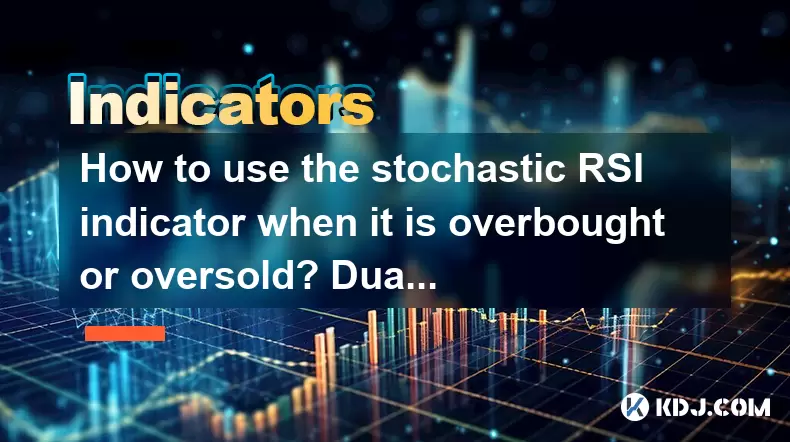-
 bitcoin
bitcoin $118548.520763 USD
3.67% -
 ethereum
ethereum $4352.564943 USD
4.79% -
 xrp
xrp $2.964058 USD
4.22% -
 tether
tether $1.000565 USD
0.05% -
 bnb
bnb $1028.372955 USD
1.46% -
 solana
solana $221.373507 USD
6.00% -
 usd-coin
usd-coin $0.999933 USD
0.02% -
 dogecoin
dogecoin $0.248633 USD
6.85% -
 tron
tron $0.341444 USD
2.38% -
 cardano
cardano $0.852946 USD
5.82% -
 hyperliquid
hyperliquid $47.869306 USD
6.15% -
 chainlink
chainlink $22.561476 USD
6.01% -
 ethena-usde
ethena-usde $1.001258 USD
0.05% -
 avalanche
avalanche $30.660000 USD
2.06% -
 stellar
stellar $0.400917 USD
9.76%
How to use the stochastic RSI indicator when it is overbought or oversold? Dual indicators filter false signals
Stochastic RSI, ranging from 0 to 1, helps traders spot overbought (>0.8) and oversold (<0.2) conditions in crypto markets, enhanced by dual indicators like MACD and Bollinger Bands.
Jun 12, 2025 at 01:50 am

The Stochastic Relative Strength Index (Stochastic RSI) is a popular technical analysis tool used by traders to identify potential overbought and oversold conditions in the cryptocurrency market. When combined with dual indicators, it can help filter out false signals and improve the accuracy of trading decisions. In this article, we will explore how to use the Stochastic RSI indicator effectively when it is overbought or oversold, and how dual indicators can enhance its reliability.
Understanding the Stochastic RSI Indicator
The Stochastic RSI is an oscillator that ranges from 0 to 1, and it is derived from the Relative Strength Index (RSI). The primary purpose of the Stochastic RSI is to identify the momentum of the RSI, providing insights into potential price reversals. The Stochastic RSI is considered overbought when it rises above 0.8 and oversold when it falls below 0.2.
To calculate the Stochastic RSI, follow these steps:
- Calculate the RSI of the asset using a chosen period (typically 14 periods).
- Calculate the Stochastic of the RSI using a chosen period (typically 14 periods).
- The resulting value is the Stochastic RSI, which oscillates between 0 and 1.
Identifying Overbought and Oversold Conditions
When the Stochastic RSI value exceeds 0.8, it suggests that the asset is in an overbought condition, indicating that the price may be due for a correction. Conversely, when the Stochastic RSI value falls below 0.2, it indicates that the asset is oversold, suggesting that the price may rebound soon.
Traders often use these levels as signals to enter or exit trades. For instance, when the Stochastic RSI is over 0.8, it might be a good time to consider selling or taking profits. When it falls below 0.2, it could be an opportunity to buy or enter long positions.
Using Dual Indicators to Filter False Signals
While the Stochastic RSI can provide valuable insights, it is prone to generating false signals, especially in highly volatile markets. To improve the reliability of the Stochastic RSI, traders can use dual indicators to filter out these false signals. Common dual indicators include the Moving Average Convergence Divergence (MACD) and the Bollinger Bands.
Combining Stochastic RSI with MACD
The MACD is a trend-following momentum indicator that shows the relationship between two moving averages of a security's price. By combining the Stochastic RSI with the MACD, traders can confirm the signals generated by the Stochastic RSI.
Here's how to use the Stochastic RSI and MACD together:
- When the Stochastic RSI indicates an overbought condition (above 0.8) and the MACD line crosses below the signal line, it suggests a strong sell signal.
- When the Stochastic RSI indicates an oversold condition (below 0.2) and the MACD line crosses above the signal line, it suggests a strong buy signal.
This dual indicator approach helps traders avoid entering trades based solely on the Stochastic RSI, which may lead to false signals.
Combining Stochastic RSI with Bollinger Bands
Bollinger Bands consist of a middle band being a simple moving average (SMA) and two outer bands that are standard deviations away from the SMA. By combining the Stochastic RSI with Bollinger Bands, traders can further validate the overbought and oversold signals.
Here's how to use the Stochastic RSI and Bollinger Bands together:
- When the Stochastic RSI indicates an overbought condition (above 0.8) and the price touches or breaks the upper Bollinger Band, it suggests a strong sell signal.
- When the Stochastic RSI indicates an oversold condition (below 0.2) and the price touches or breaks the lower Bollinger Band, it suggests a strong buy signal.
This combination helps traders identify potential reversal points more accurately by considering both the momentum and the price action.
Practical Application of Stochastic RSI and Dual Indicators
To effectively use the Stochastic RSI and dual indicators in trading, follow these steps:
- Set up your trading platform: Ensure that your trading platform supports the Stochastic RSI, MACD, and Bollinger Bands indicators. Most popular platforms like TradingView, MetaTrader, and others offer these tools.
- Configure the indicators: Set the Stochastic RSI period to 14, the MACD settings to 12, 26, and 9 (standard settings), and the Bollinger Bands to a 20-period SMA with 2 standard deviations.
- Monitor the Stochastic RSI: Watch for the Stochastic RSI to move above 0.8 (overbought) or below 0.2 (oversold).
- Confirm with dual indicators: Use the MACD and Bollinger Bands to validate the signals from the Stochastic RSI.
- Execute trades: Enter or exit trades based on the confirmed signals from the combined indicators.
Case Study: Using Stochastic RSI and Dual Indicators in Bitcoin Trading
Let's consider a practical example of using the Stochastic RSI and dual indicators in trading Bitcoin (BTC).
- Scenario 1: Overbought Signal
- The Stochastic RSI rises above 0.8, indicating that Bitcoin is overbought.
- The MACD line crosses below the signal line, confirming the sell signal.
- The price of Bitcoin touches the upper Bollinger Band, further validating the overbought condition.
- Based on these signals, a trader decides to sell Bitcoin, anticipating a price correction.
- Scenario 2: Oversold Signal
- The Stochastic RSI falls below 0.2, indicating that Bitcoin is oversold.
- The MACD line crosses above the signal line, confirming the buy signal.
- The price of Bitcoin touches the lower Bollinger Band, further validating the oversold condition.
- Based on these signals, a trader decides to buy Bitcoin, expecting a price rebound.
Tips for Effective Use of Stochastic RSI and Dual Indicators
To maximize the effectiveness of the Stochastic RSI and dual indicators, consider the following tips:
- Use multiple time frames: Analyze the Stochastic RSI and dual indicators across different time frames (e.g., 1-hour, 4-hour, and daily charts) to get a comprehensive view of the market.
- Avoid trading during high volatility: The Stochastic RSI can generate false signals during periods of high volatility. Be cautious and consider waiting for the market to stabilize before making trading decisions.
- Combine with other technical analysis tools: Use additional technical analysis tools such as support and resistance levels, trend lines, and chart patterns to further validate your trading signals.
- Practice risk management: Always use stop-loss orders and manage your position sizes to minimize potential losses.
Frequently Asked Questions
Q1: Can the Stochastic RSI be used for all cryptocurrencies, or is it better suited for specific types of assets?A1: The Stochastic RSI can be used for all cryptocurrencies, but its effectiveness may vary depending on the asset's volatility and trading volume. Highly liquid assets like Bitcoin and Ethereum may provide more reliable signals, while less liquid assets might generate more false signals due to erratic price movements.
Q2: How often should I check the Stochastic RSI and dual indicators for trading signals?A2: The frequency of checking the Stochastic RSI and dual indicators depends on your trading style. For day traders, checking every 15 minutes to an hour can be beneficial. Swing traders might check the indicators once or twice a day, while long-term investors may review them on a weekly basis.
Q3: Are there any specific settings for the Stochastic RSI and dual indicators that work best for cryptocurrency trading?A3: While the standard settings for the Stochastic RSI (14 periods), MACD (12, 26, 9), and Bollinger Bands (20 periods, 2 standard deviations) are commonly used, some traders may find that adjusting these settings to suit their trading style and the specific cryptocurrency's volatility can improve results. Experimenting with different settings on historical data can help identify the most effective parameters.
Q4: Can the Stochastic RSI and dual indicators be used for automated trading strategies?A4: Yes, the Stochastic RSI and dual indicators can be integrated into automated trading strategies. Many trading platforms and software support the use of these indicators in algorithmic trading. However, it is crucial to thoroughly backtest any automated strategy using historical data to ensure its reliability and performance before deploying it in live trading.
Disclaimer:info@kdj.com
The information provided is not trading advice. kdj.com does not assume any responsibility for any investments made based on the information provided in this article. Cryptocurrencies are highly volatile and it is highly recommended that you invest with caution after thorough research!
If you believe that the content used on this website infringes your copyright, please contact us immediately (info@kdj.com) and we will delete it promptly.
- BlockDAG, DOGE, HYPE Sponsorship: Crypto Trends Shaping 2025
- 2025-10-01 00:25:13
- Deutsche Börse and Circle: A StableCoin Adoption Powerhouse in Europe
- 2025-10-01 00:25:13
- BlockDAG's Presale Buzz: Is It the Crypto to Watch in October 2025?
- 2025-10-01 00:30:13
- Bitcoin, Crypto, and IQ: When Genius Meets Digital Gold?
- 2025-10-01 00:30:13
- Stablecoins, American Innovation, and Wallet Tokens: The Next Frontier
- 2025-10-01 00:35:12
- NBU, Coins, and Crypto in Ukraine: A New Yorker's Take
- 2025-10-01 00:45:14
Related knowledge

What is a tower bottom candlestick pattern? Does it have a high success rate?
Sep 22,2025 at 07:18am
Tower Bottom Candlestick Pattern Explained1. The tower bottom candlestick pattern is a reversal formation that typically appears at the end of a downt...

What is a black hole pattern in the MACD indicator? Is it a cause for concern?
Sep 21,2025 at 06:54pm
Bitcoin's Role in Decentralized Finance1. Bitcoin remains the cornerstone of decentralized finance, serving as a benchmark for value and security acro...

How can I use the psychological line (PSY) to determine market sentiment?
Sep 17,2025 at 02:19pm
Understanding the Psychological Line (PSY) in Cryptocurrency TradingThe Psychological Line, commonly referred to as PSY, is a momentum oscillator used...

How can I determine if a double top pattern has officially formed?
Sep 21,2025 at 03:18am
Understanding the Structure of a Double Top Pattern1. A double top pattern consists of two distinct peaks that reach approximately the same price leve...

What is the Golden Valley pattern on the moving average? Is it better than the Silver Valley pattern?
Sep 21,2025 at 02:54pm
Understanding the Golden Valley Pattern in Moving Averages1. The Golden Valley pattern is a technical formation observed in cryptocurrency price chart...

What does a death cross of the RSI in the strong zone (above 50) mean?
Sep 17,2025 at 10:54pm
Understanding the Death Cross in RSI Context1. The term 'death cross' is traditionally associated with moving averages, where a short-term average cro...

What is a tower bottom candlestick pattern? Does it have a high success rate?
Sep 22,2025 at 07:18am
Tower Bottom Candlestick Pattern Explained1. The tower bottom candlestick pattern is a reversal formation that typically appears at the end of a downt...

What is a black hole pattern in the MACD indicator? Is it a cause for concern?
Sep 21,2025 at 06:54pm
Bitcoin's Role in Decentralized Finance1. Bitcoin remains the cornerstone of decentralized finance, serving as a benchmark for value and security acro...

How can I use the psychological line (PSY) to determine market sentiment?
Sep 17,2025 at 02:19pm
Understanding the Psychological Line (PSY) in Cryptocurrency TradingThe Psychological Line, commonly referred to as PSY, is a momentum oscillator used...

How can I determine if a double top pattern has officially formed?
Sep 21,2025 at 03:18am
Understanding the Structure of a Double Top Pattern1. A double top pattern consists of two distinct peaks that reach approximately the same price leve...

What is the Golden Valley pattern on the moving average? Is it better than the Silver Valley pattern?
Sep 21,2025 at 02:54pm
Understanding the Golden Valley Pattern in Moving Averages1. The Golden Valley pattern is a technical formation observed in cryptocurrency price chart...

What does a death cross of the RSI in the strong zone (above 50) mean?
Sep 17,2025 at 10:54pm
Understanding the Death Cross in RSI Context1. The term 'death cross' is traditionally associated with moving averages, where a short-term average cro...
See all articles










































































